Don't wanna be here? Send us removal request.
Text
When the Zombie Nazis are explaining how they got to Hell to Furfur, Glozier describes Aziraphale as "a sissy type, a real fagelah", which is a slur calling Aziraphale a homosexual and meaning that in a derogatory way as, you know, Glozier is a Nazi... What is funny about it in the context of the scene is that the word is Yiddish, so the scene amounts to a British Nazi using Jewish words to slur homosexuals, in truly stupid fascist form lol. But that's not why I'm mentioning it. There's a Crowley & Aziraphale reason, as you'll see below.
Furfur's dialogue in the scene then also adds more humor when he tells them to be quiet for a second by telling them to "schtum"-- a British English slang word for "being quiet/keeping quiet" that is Yiddish and comes from the German word "stumm" aka "silence". It's telling Nazis to shut up using a word that has been taken into its own meaning by groups the Nazis have been attacking.
But the reason why I bring it up to you all is because the word "fagelah" means "little bird" and "schtum" means "silence" so the Yiddish in the 'Furfur meets the Zombie Nazis' scene translates to...
Silent little birds. Or, as we know it in Good Omens...

2K notes
·
View notes
Text
I'm seeing some confusion out and about over the title A Companion to Owls (generally along the lines of 'what have owls got to do with it???'), so I'd like to offer my interpretation (with a general disclaimer that the Bible and particularly the Old Testament are damn complicated and I'm not able to address every nuance in a fandom tumblr post, okay? Okay):
It's a phrase taken from the Book of Job. Here's the quote in full (King James version):
When I looked for good, then evil came unto me: and when I waited for light, there came darkness. My bowels boiled, and rested not: the days of affliction prevented me. I went mourning without the sun: I stood up, and I cried in the congregation. I am a brother to dragons, and a companion to owls. --(Job 30:29)
Job is describing the depths of his grief, but also, with that last line, his position in the web of providence.
Throughout the Old Testament, owls are a recurring symbol of spiritual devastation. Deuteronomy 4:17 - Isaiah 34:11 - Psalm 102: 3 - Jeremiah 50: 39...just to name a few (there's more). The general shape of the metaphor is this: owls are solitary, night-stalking creatures, that let out either mournful cries or terrible shrieks, that inhabit the desolate places of the world...and (this is important) they are unclean.
They represent a despair that is to be shunned, not pitied, because their condition is self-inflicted. You defied God (so the owl signifies), and your punishment is...separation. From God, from others, from the world itself. To call and call and never, ever receive an answer.
Your punishment is terrible, tormenting loneliness.
(and that exact phrase, "tormenting loneliness," doesn't come from me...I'm pulling it from actual debate/academia on this exact topic. The owls, and what they are an omen for. Oof.)
To call yourself a 'companion to owls,' then, is to count yourself alongside perhaps the most tragic of the damned --not the ones who defy God out of wickedness or ignorance, and in exile take up diabolical ends readily enough...but the ones who know enough to mourn what they have lost.
So, that's how the title relates to Job: directly. Of course, all that is just context. The titular "companion to owls," in this case, isn't Job at all.
Because this story is about Aziraphale.
The thing is that Job never actually defied God at all, but Aziraphale does, and he does so fully believing that he will fall.
He does so fully believing that he's giving in to a temptation.
He's wrong about that, but still...he's realized something terrifying. Which is that doing God's will and doing what's right are sometimes mutually exclusive. Even more terrifying: it turns out that, given the choice between the two...he chooses what's right.
And he's seemingly the only angel who does. He's seemingly the only angel who can even see what's wrong.
Fallen or not, that's the kind of knowledge that...separates you.
(Whoooo-eeeeee, tormenting loneliness!!!)
Aziraphale is the companion.
...I don't think I need to wax poetic about Aziraphale's loneliness and grappling with devotion --I think we all, like, get it, and other people have likely said it better anyway. So, one last thing before I stop rambling:
Check out Crowley's glasses.

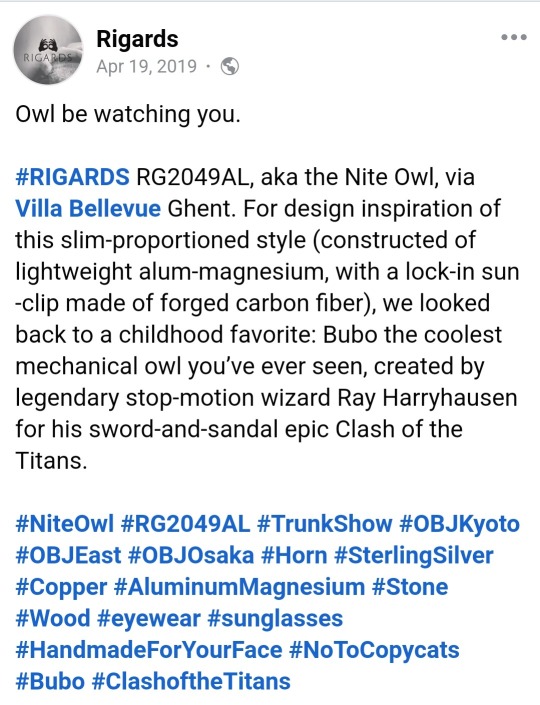
(screenshots from @seedsofwinter)
Crowley is the owl.
Crowley is the goddamn owl.
3K notes
·
View notes
Note
So it could be really normal for Gabriel to think that Aziraphale or Crowley could give birth.(In a human way (As they are so good as a spy on earth😘
in the job minisode Aziraphale mentions that Gabriel witnesses the first human birth in the garden of Eden, but didn't eve get kicked out of the garden while she was still pregnant?
Yup.
That wasn't the birth he was referring to. The one Gabriel saw had ribs in it.
4K notes
·
View notes
Text
Amazing job!!!
Aziraphale's Illustrated Bible
There are a lot of interesting items stored within Aziraphale's bookshop and one I find fascinating is the bible (or bibles) that are typically on the stand next to his desk and which they use for the Job flashback/memory sequence. Here's what these books look like in episode 2 - the blue detailed folio, the beige folio held by Aziraphale, and this same beige folio when opened to Job:


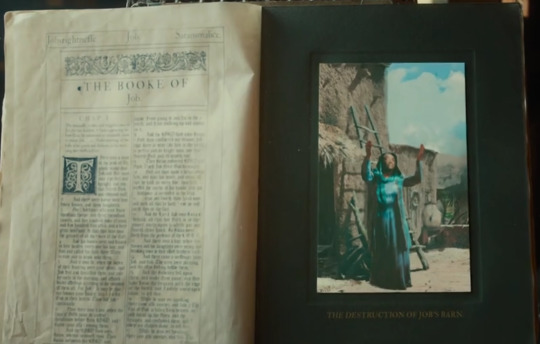
You might not have noticed yet, but there are several other images shown in this book in the second season! Often the book is out of focus and far from the camera, but some sleuths on reddit were able to identify the particular images being shown.
Let's take a look at those images and where they occur in the show. All of these images are famous illustrations by Harold Copping:
1. "Joseph knows his brethren" - Book of Genesis, Old Testament
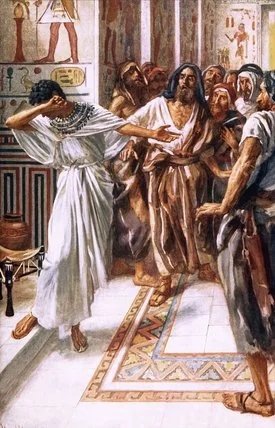
This image is on display in episode 1 and looks like this on camera. To spot it, I used the little telltale shadow that is created on the ground:
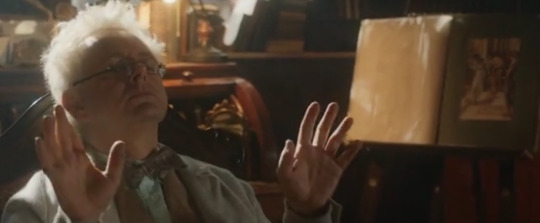
The story of Joseph may be more familiar to you as "Joseph and the Technicolour Dreamcoat". I've certainly had to brush up on my bible knowledge myself, so please, if you know more than I do and I've gone wrong anywhere let me know. Joseph is rejected by his family and they believe him dead. He then gets promoted to a high-up position in Egypt. The image depicted is when Joseph is reunited with his estranged brothers and they don't recognise him at first (something which happens a lot in season 2!). However, Joseph recognises them and he pretends to be a stranger to them at first. Eventually, he clears the room and says to them "I am Joseph! Is my father still living?". I'm sure there is more to unpack in this story but I'll leave that for someone with better biblical knowledge.
2. "Jacob's vow" - Book of Genesis, Old Testament
This image appears in episode 2:
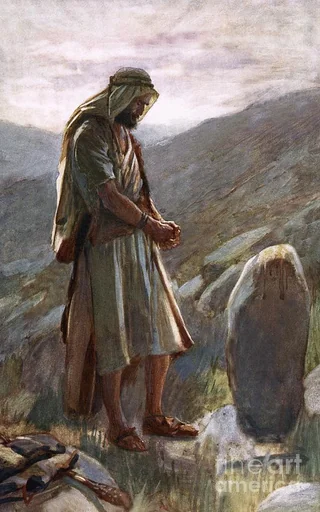
In the episode, it first appears in the background looking like this:

According to comments on the reddit post, this image could refer to "Jacob’s vow in Bethel, that’s when he promised to worship God if God took care of him, and it was the day after his famous dream about a ladder in heaven. It is generally a symbol of the link between heaven and Earth." Here is a quote from the exact passage: "Genesis 28:20 Then Jacob made a vow, saying, “If God will be with me, and keep me in this way that I am going, and give me bread to eat and clothing to put on, so that I come back to my father's house in peace, then the lord shall be my God. And this stone which I have set as a pillar will be God's house, and of all that you give me, I will surely give a tenth to you." We see a lot of emphasis on food giving this season. The Eccles cakes get offered to Maggie then handed to Crowley. Gabriel offers up lots of little snacks at the ball. The Metatron gifts Aziraphale the coffee. At the ball, we see people being given new clothes as well - is that what this could be referencing? Why do you think these particular images have been chosen?
3. "The Brazen Serpent" - Book of Numbers, Old Testament
What do we think of when we hear "serpent"? Anything snake-like refers to Crowley in this show, so that's where my mind immediately goes.
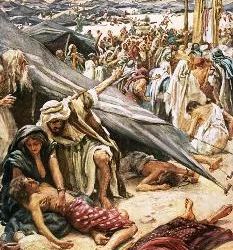
This appears in episode 3 looking like this (partially occluded):

The story is that God had sent fiery serpents to attack the Israelites for making complaints about God and Moses (no asking questions, no complaints? What kind of organisation is this? They really need to unionise). However, God seems to then have a change of heart and commanded Moses to erect a snake upon a pole, referred to as "Nehushtan", so that anyone bitten by the snakes can just look at this pole and they will survive.
We get some pretty wacky stories about God's fickleness in Good Omens, especially in the S2 Job flashbacks. Is this a reflection of that theme, perhaps.
4. "By the rivers of Babylon" - Book of Psalms, Old Testament
If you don't have a Christian background, you may be more familiar with the song than the story itself. From the wikipedia article: "The song is based on the Biblical Psalm 137:1-4, a hymn expressing the lamentations of the Jewish people in exile following the Babylonian conquest of Jerusalem in 586 BC".
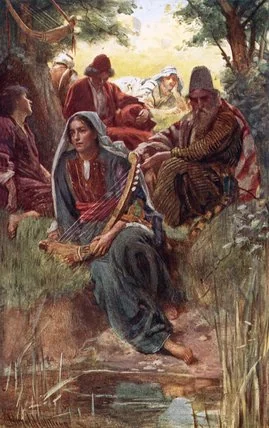
It appears in episode 5 and looks like this:
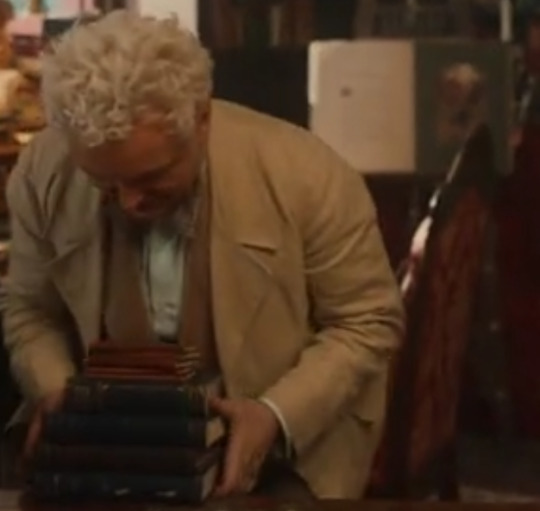
One Redditor has explained it as such: "The rivers of Babylon symbolize deep grief and longing for freedom by people exiled from their homeland and doomed to live in captivity."
5. Closed Book(s)
The book also appears closed at times. Let's take a look at the scene where Aziraphale retrieves the book for the Job flashback. We see him getting out the beige folio and putting it onto the stand but over the top of an almost identical book. The only difference is that the Job one has blue detailing and the other is a plain/beige cover (seen here in this third image with Crowley, episode 6).



So what is this other book? Well, looking online, it appears that Harold Copping's illustrated bibles could come in sets of two - one for the Old Testament, and one for the New Testament. All the illustrations we see in S2 are from the Old Testament, so why would the New Testament also be there? When explaining this to someone they mentioned that Aziraphale has a lot of misprinted bibles in his collection. So could they instead be two different versions of the same text - one with misprints and one without? I'd be keen to hear your thoughts.
6. Bonus Season 1 Appearance!
In Season One, we also see a Harold Copping illustration - Adam and Eve after the Fall.
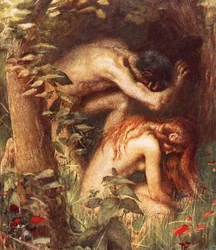
The book is in the same place inside the bookshop, as show in episode 1 (26:21) and episode 2 (51:40).
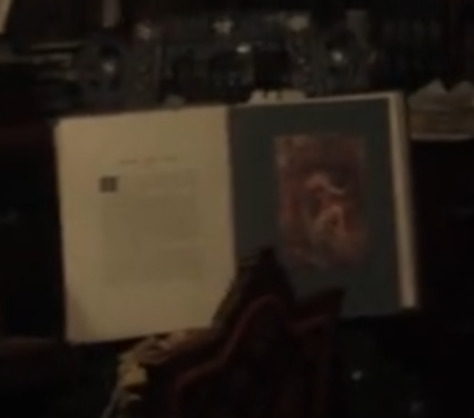
Beyond supporting the themes of Good Omens these books are useful in another way too - finding discontinuities! If you are interested in the discontinuities of Good Omens S2, then please check out this post:
266 notes
·
View notes
Text

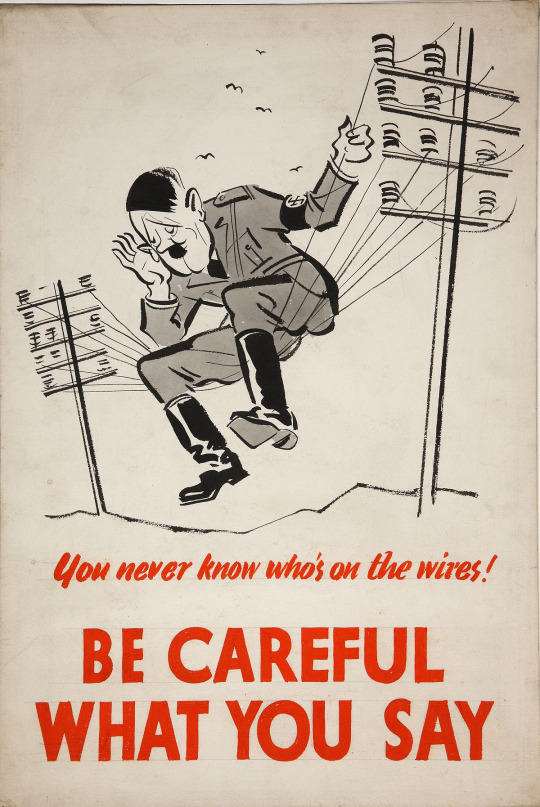
I love the fact that Hell sees Heaven and God as Nazis and Hitler basically
I mean that’s my interpretation of course.
113 notes
·
View notes
Text
He has suggestions!!!!!!!!!!!!

Hello Good Omens Fandom, you have landed on the nice list for the holidays: we present the Aziraphale & Crowley Angelic Playlist. @neil-gaiman
13K notes
·
View notes
Note
Thank you😭 One more thing I need to watch
Good afternoon.
Sir Neil, I admire and respect you.
In addition, a friend and I spend almost every night analysing "good omens" for evidence of various theories, so we were wondering if you have seen the 1949 film The small back room ?
Thanks.
The one we named Maggie's record shop after, you mean? The record shop filled with Powell and Pressburger film posters?
Could be.
2K notes
·
View notes
Note
is good omens worth it? Should I watch it?
No. Definitely not. Avoid it at costs. Otherwise you can find yourself sucked in to the story and characters and doomed.
5K notes
·
View notes
Text
Like this! I have no idea about the pattern on the sweater.
Memento mori

If you have the Good Omens book, you have probably seen the little winged hourglasses that act as section separators.
Then if you paid attention during S2, you would have noticed at least two visual representations of hourglasses appear: One on Jimbriel's assistant shopkeeper vest and a large one in Hell itself.

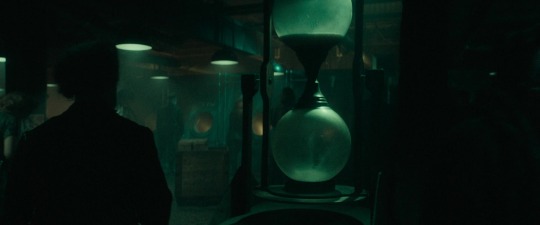
(There are actually two time-related symbols on Jim's vest, but I'll start with the hourglass symbol.)
These are collectively known as the Memento mori, which is usually translated from the Latin into "remember that you die." It is a philosophical reminder about the inevitability of death, one of the major themes in GOmens, which is ironic since we are seeing from the viewpoint of immortal entities who don't have to face it themselves.
Artistically you may see this expressed by a skull and bones, or a skeleton, a coffin, or wilting flowers. Another form of it is the popular saying tempus fugit or "time flees" inscribed on sundials.
We can also hear it - the Danse Macabre, the piece of music the Bentley plays for Aziraphale on the way to Edinburgh, is another example of this theme, as it depicts the Grim Reaper carrying off the rich and poor alike.

Hurry up Aziraphale, you don't have all day!
The other time-related symbol on Jimbriel's vest is the ancient Greek meander pattern, named after the Maeander river in modern day Turkey.
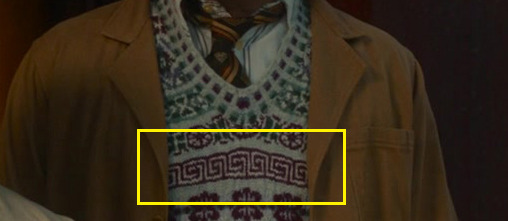
This represents a winding river folding back on itself in big looping oxbow bends. Symbolically it represents both unity and infinity - the undulating flow of human life that continues on and on into eternity through reproduction.
Sounds like something we've heard before:
AZIRAPHALE: Ah. The point. Ah, well, you've heard of Earth? CROWLEY: Ehhh… Not as such? AZIRAPHALE: Ah. Blue-green planet. It'll be over there somewhere when they roll out that quadrant. Now that's where the “people” that we're currently designing are going to be. I've seen the plans. We're going to start out with a breeding pair, and then pretty soon there'll be oodles of them! They'll breed like...um...well, they'll breed like people.
OK, then. That kind of sums up the two competing main themes in Good Omens nicely. Everthing Has An End or Eternity.
The problem is, they both sound equally horrific.
154 notes
·
View notes
Note
Writing question here. Do you ever find yourself, mid writing project, doubting your story? And if so, what do you do to get through it?
Keep writing.
3K notes
·
View notes
Text
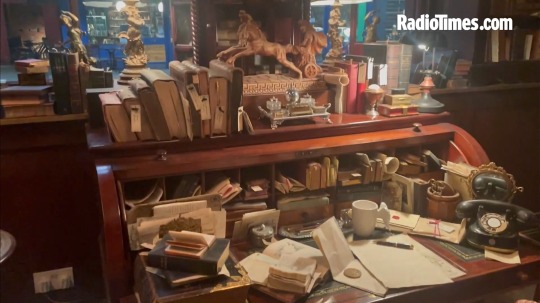
I was minding my own business and analyzing another part of the A. Z. Fell & Co. bookshop from the Radio Times footage when I noticed something interesting on Aziraphale’s desk. It looks like the angel was studying a handwritten copy of someone’s last will and testament and left in a hurry, with a bronze medal and a fountain pen on top of it. And… an attachment of a land registry plan, barely visible underneath.
Obviously that’s when my South Downs obsessed brain turned all of its alarms on and decided to read the whole thing. And look for the missing parts, since only a portion of the original document was visible on screen. Unfortunately the full text is much longer and less exciting than anticipated, and — spoiler alert — related to a different area of the country, but still relevant to the Good Omens universe. We’ll look into that in a moment.
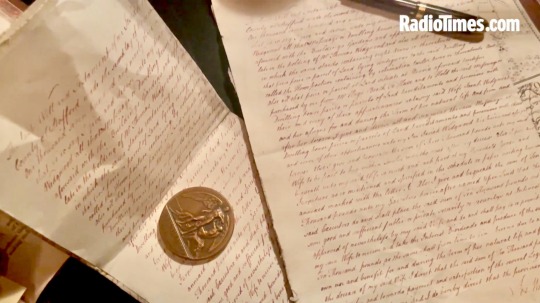
Let’s start with the struck bronze medal — acting here as a paperweight, which makes the documents in question already stand out from the usual bumph and bric-a-brac accumulated by Aziraphale over an unknown period of time on his desk.
It’s a very interesting rendition of the mythological scene centered around Daedalus fastening the wings onto his son Icarus (little does he know that this attempt to escape imprisonment will lead to his son’s demise). Contrary to popular sentiment in the history of art, this particular version of Icarus isn’t depicted as a child or teenager, but as a warrior donning a helmet and preparing himself to battle. Which makes perfect sense after discovering that it was made for the Royal Air Force Athletic & Cross Country Association’s WAAF Athletic Championships in 1945. There’s some poetic irony in the fact that the medal was apparently given to the third place winner in a high jump category.
Apart from its obviously military style, this concept seems inspired by a 1885-86 medal by Auguste Patey commemorating the experimental flights at the first French wind tunnel at Chalais-Meudon, a town on the banks of the Seine near Paris. On 9 August 1884, engineers Charles Renard and Arthur Constantin Krebs made the first controllable free flight there when they piloted their airship, La France, over a course and returned to their starting point. From 9 August 1884 to 23 September 1885, La France made seven flights and was able to return to its starting point five times.

The last Will and Testament of Josiah Wedgwood
The last Will and Testament of me, Josiah Wedgwood, of Etruria, in the County of Stafford, made the second day of November, in the year of Our Lord one thousand seven hundred and ninety-three, in manner and form following (that is to say): I give and bequeath unto my dear and affectionate Wife, Sarah Wedgwood, all that messuage or dwelling-house situate at or near Etruria aforesaid, with the buildings, gardens, and appurtenances thereto belonging, late in the holding of Mr. Thomas Wedgwood; and also all that field or piece of land in which the same stands, containing eight acres or thereabouts; and also all that close, piece, or parcel of land lying contiguous to the said dwelling-house, called the Horse Pasture, containing by estimation twelve acres or thereabouts; and also all that piece or parcel of land situate at Etruria aforesaid, heretofore purchased by me from Mr. Hugh Booth; To have and to hold the said messuage or dwelling-house, pieces or parcels of land, hereditaments and premises, with their and every of their appurtenances, unto my said Wife, Sarah Wedgwood and her assigns, for and during the term of her natural life. And from and after her decease, I give and devise all and singular the said messuage or dwelling-house, pieces or parcels of land, hereditaments, and premises, with their and every of their appurtenances, unto my Son, Josiah Wedgwood, his heirs and assigns for ever. Also I give and bequeath the sum of three thousand pounds unto my said Wife, to be paid to her within twelve months next after my decease. Also I give and bequeath unto my said Wife so much and such part of my household goods and furniture as is mentioned and specified in the Schedule or Paper Writing hereunto annexed, marked with the Letter A. Also I give and bequeath the sum of ten thousand pounds unto my Executors hereinafter named, upon trust that they, my said Executors, do and shall place the said sum of ten thousand pounds out upon some good and sufficient public or private security or securitys, at interest, to be approved of nevertheless by my said Wife, and do and shall pay to, or permit and suffer my said Wife to receive and take the interest, dividends, and produce of the said sum of Ten thousand pounds, as the same shall from time to time become due to and for her own use and benefit for and during the term of her natural life.
And from and after the decease of my said Wife, I direct that the said sum of ten thousand pounds shall be applied for and towards payment and satisfaction of the several legacys or sums of money hereinafter given by me. And I do hereby direct that the provision hereinbefore made or intended for my said Wife shall be in lieu, bar, and satisfaction of dower and thirds at Common Law. Also I give and devise unto my said Executors, for the use of my said son, Josiah Wedgwood, his heirs and assigns for ever, that part of Etruria Estate which I now occupy, upon the north side of the Turnpike Road leading from Newcastle to Leek, with the house I now live in, the outbuildings belonging to the same, with the pleasure grounds and all appurtenances thereto belonging, being about sixty-five acres; and also another part of the Etruria Estate, now in the occupation of Richard Hall, being about sixty-eight acres; And also another part of the Etruria Estate, now in the occupation of Thomas Ford, being about forty-five acres; and also the Estate late a part of the White House Estate, on the south side the Turnpike Road leading from Newcastle to Leek; and likewise the land purchased from Thomas Heath, with a small meadow on the north side the said Road, and lying in the Parish of Woolstanton; and likewise a meadow lately purchased from John Mare, of Handley, — all in the holding of Richard Billington, being altogether about eighty-one acres; and also a piece of land on the south side of the same Road, now in the holding of Daniel Haywood, being about two acres; and also an Estate bought from George Taylor, and now in the holding of Jonathan Adams, being about nine acres; and also a small piece of land adjoining the land bought from Hugh Booth, together with a part of the Hough Meadow, and now in the holding of John Ryder, being about four acres; and also an estate called the Spittels, situate in Penkhull, in the Parish of Stoke upon Trent, and lately purchased from James Godwin, containing sixty-three acres or thereabouts; and also an Estate adjoining to the Spittels on one side, and to Stoke Lane on the other, situate in Penkhull aforesaid, in the Parish of Stoke upon Trent, late in the holding of Humphrey Ratcliff, containing fifteen acres or thereabouts; and also a piece of land called the Woodhills, situate in the Parish of Stoke upon Trent, lately purchased from Ralph Baddeley, and now in my own occupation, being about eleven acres; and also all buildings, tenements, houses, farmhouses, outhouses, pot works, warehouses, workshops, and other buildings, of what kind soever they may be, situate, standing, and being upon any of the land or premises above named, and not hereinbefore devised; and also all my share of the models and molds of the Manufactory in Etruria aforesaid. Also I give and bequeath the sum of thirty thousand pounds unto my son John Wedgwood. Also I give and bequeath the sum of twenty-nine thousand one hundred and ten pounds, and likewise twenty shares in the Monmouthshire Canal, unto my Son Thomas Wedgwood.
Also I give and bequeath the sum of twenty-five thousand pounds unto my daughter Susannah Wedgwood; and which said several legacys or sums of thirty thousand pounds, and twenty-nine thousand one hundred and ten pounds, and twenty shares in the Monmouthshire Canal, and twenty-five thousand pounds, so given to my said Son John Wedgwood, and to my said Son Thomas Wedgwood, and to my said Daughter Susannah Wedgwood, I do hereby direct shall be paid to them as soon as conveniently may be after my decease, together with interest for the same in the mean time, after the rate of four pounds and ten shillings per centum per annum. Also I give and bequeath the sum of twenty-five thousand pounds unto my Daughter Catharine Wedgwood, to be paid to her as soon after her age of twenty-one years, or day of marriage, which shall first happen, as conveniently may be, with interest for the same in the mean time after the rate of four pounds and ten shillings per centum per annum. Also I give and bequeath the sum of twenty-five thousand pounds unto my Daughter Sarah Wedgwood, to be paid to her as soon after her age of twenty-one years, or day of marriage, which shall first happen, as conveniently may be, with interest for the same in the mean time after the rate of four pounds and ten shillings per centum per annum. Provided always, and I do hereby direct, that in case my said Daughters Catherine Wedgwood and Sarah Wedgwood, or either of them, shall happen to die unmarried before the age of twenty-one years, then that the legacy or legacys of her or them so dying shall sink into and become part of the residue of my personal Estate, and be applied and disposed of accordingly, as shall hereinafter be mentioned. Also I do hereby declare it to be my will that all the rest, residue, and remainder of my said stock in trade, goods, wares, implements, materials, and utensils of trade, and other matters and things used by me, in or belonging to my said Manufactory, except the models or molds therein used or kept, shall, at the time of my decease, sink into and become part of the residue of my personal estate, and be applied and disposed of accordingly. Also I give and bequeath all and singular my household goods and furniture not hereinbefore given to my said Wife, together with all my books, prints, books of prints, pictures, and cabinets of Experiments, of Fossils, and of Natural History, unto my said Son Josiah Wedgwood. And I do hereby commit the Guardianship and Tuition of such of my said children as shall not at the time of my decease have attained the age of twenty-one years unto my said Wife and my said Son John Wedgwood, until such children shall attain the said age. And I do direct that the fortunes or portions of such of my said children shall in the mean time be managed by my said Wife and my said Son John Wedgwood, and a competent part of the interest and produce thereof be applied for their maintenance and education, and the residue of such interest and produce be suffered to accumulate for their benefit and advantage in such manner as my said Wife and Son John Wedgwood shall in their discretion think most meet and proper.
Also I givo and bequeath one annuity or yearly sum of twenty pounds unto my Brother in Law, Philip Clark, for and during the term of his natural life. Also I give and bequeath one annuity or yearly sum of Twenty pounds unto my Niece, Sarah Taylor, for and during the term of her natural life. Also I give and bequeath one annuity or yearly sum of twenty pounds unto Mr. Alexander Chisholm, for and during the term of his natural life; recommending it to my Son Josiah Wedgwood to give him any further assistance that he may stand in need of, to make the remainder of his life easy and comfortable. And I do hereby direct that the said several and respective annuitys of twenty pounds, twenty pounds, and twenty pounds shall be paid and payable quarterly, at the four most usual feasts or days of payment in the year, (that is to say) on every twenty-fifth day of March, twenty-fourth day of June, twenty-ninth day of September, and twenty-fifth day of December, by even and equal portions, free and clear of and from all taxes, charges, and deductions whatsoever; the first payment thereof to begin and be made on such of the said days as shall first and next happen after my decease. Also I give and bequeath the sum of ten guineas unto the said Alexander Chisholm, as a testimony of my regard for him. Also I give and bequeath the sum of two hundred pounds apiece unto all and every the children of my Nephew Thomas Byerley, who shall be living at the time of my decease, to be paid to them at their respective ages of twenty-one years: Provided always, and in case any one or more of the said children shall happen to die without issue before he, she, or they shall attain the said age, then I direct that the legacy or legacys to him, her, or them so dying shall go and be paid unto and amongst the survivors or survivor of them equally, share and share alike, in case there shall be more than one, at such time and in such manner as is hereinbefore directed and expressed of and concerning the said original legacys or sums of two hundred pounds: Provided also, and in case all the said children shall happen to die without issue before they shall attain the said age, then I direct that all the said legacies or sums of Two hundred pounds so given to them as aforesaid shall sink into and become part of the residue of my personal estate, and be applied and disposed of accordingly. And I do hereby expressly direct and declare that no interest shall be allowed or paid upon the said respective legacys or sums of two hundred pounds in the mean time from my decease to the time that the same shall become payable by virtue of this my Will; such legacys or sums of two hundred pounds being given by me in lieu of legacys or sums of one hundred pounds, which it was originally my intention to have directed to be placed out at interest, and to have accumulated for such children of the said Thomas Byerley as aforesaid until they should attain the age of twenty-one years. Also I give and bequeath unto each of my Nephews Thomas and John Wedgwood, Sons of my late Nephew Thomas Wedgwood, of the Upper House in Burslem, the sum of two hundred pounds each, to be paid to them at their respective ages of twenty-one years: Provided always, and in case they shall either or both of them die before they arrive at the age of twenty-one years, I direct that the legacy or legacys of the party or parties so dying, of two hundred pounds so given to them as aforesaid, shall sink into and become part of the residue of my personal estate, and be applied and disposed of accordingly.
Also I give to my Servant George Jones the sum of twenty guineas, as a token of my remembrance of his faithful services to me. Also I give and bequeath to the several persons whose names shall be mentioned and comprised in the Schedule or List hereto annexed, signed with my name, and marked with the letter "B," the mourning Rings or other small legacys or sums of money which shall be therein specified and expressed. Also I give and bequeath unto James Caldwell, Esq., of Newcastle under Lyme, in the County of Stafford, the sum of one hundred pounds, which I desire he will accept as a testimony of my friendship and esteem for him. And I do hereby direct and appoint that my said Nephew Thomas Byerley shall, under the direction of my Executors, settle my accounts and manage and conduct the collection of my debts and other matters relating to the settlement of my concerns in business; and that a Salary of one hundred pounds per annum be allowed and paid to him for such particular service, so long as he shall be employed therein, over and above all charges and expenses attending the same. And it is also my Will that an estate at Burslem, late in the occupation of Joseph Wedgwood, consisting of a newly erected dwelling house, a set of pot works, with other buildings, and a field called the Cross Hill, containing altogether about two acres; and likewise an estate in the Parish of Astbury, in the County of Chester, called Spengreen, and now in the holding of Thomas Johnson, containing about seventy-five acres or thereabouts; and also a piece of land on the east side of the Bridge in Congleton, in the said County of Chester, being about two rods; and also all the rest, residue, and remainder, messages, lands, tenements, hereditaments, and real estate, money, securities for money, debts due and owing, personal Estate and Effects of what nature or kind soever or wheresoever, not hereinbefore particularly devised or disposed of, together with such or so much of the several sums of money hereinbefore mentioned and bequeathed as shall, by means of the contingencies and directions hereinbefore expressed, shall all of them sink into and become parts of the said residue of my personal Estate. And I do hereby give, devise, and bequeath the same unto my said Executors, for the payment of the legacys and annuities hereinbefore mentioned; and provided there should be a residue after the above mentioned payments, then I direct that such residue shall go and be divided unto and amongst my said children, John Wedgwood, Thomas Wedgwood, Susannah Wedgwood, Catherine Wedgwood, and Sarah Wedgwood, their heirs, executors, administrators, and assigns, equally, share and share alike, as tenants in common, and not as joint tenants; and if there should be any deficiency of real or personal estates for paying the said legacys and annuitys, such deficiency shall in that case be born equally amongst and made up by those my said children above named, (that is to say) John Wedgwood, Thomas Wedgwood, Susannah Wedgwood, Catherine Wedgwood, and Sarah Wedgwood, share and share alike, in proportion to the amount of the legacys to them herein left and bequeathed. And I do hereby nominate, constitute, and appoint my said Wife, my said Son John Wedgwood, and the said James Caldwell, Esq., Executrix and Executors of this my Will. And lastly, I do hereby revoke all former or other Will or Wills by me at any time heretofore made, and do declare this only to be my last Will and Testament.
In witness whereof I have to this my last Will and Testament, contained in six sheets of paper, and have to each of the first five sheets thereof set my hand, and to the sixth and last sheet thereof my hand and seal the day and year first before written. — Jos. Wedgwood (L.S.)
Signed, sealed, published, and declared by the said Josiah Wedgwood, as and for his last Will and Testament, in the presence of us, who in his presence, and in the presence of each other, have hereunto subscribed our names as witnesses thereto; the several following words being first interlined: money—my—happen—said. — Alexr. Chisholm, Thomas Mitchell, Joseph Mitchell, Joseph Rutland
John Wedgwood, of Etruria, in the County of Stafford, Esquire, maketh oath, and saith that he has searched among the papers and writings of his late Father, Josiah Wedgwood, late of Etruria aforesaid, Esquire, deceased, in order to find certain Schedules or Paper Writings referred to in the last Will and Testament of the said Josiah Wedgwood, and therein mentioned to be annexed thereto, and respectively marked A and B. And this Deponent further saith that he has not been able to find such Schedules or Paper Writings, or either of them; and this Deponent further saith that he has never heard or been informed, nor does he believe that the said Josiah Wedgwood ever wrote or made out, or caused to be written or made out, such Schedules or Paper Writings, or either of them. — John Wedgwood
Sworn at Newcastle under Lyme, in the County of Stafford, the 29th day of June, 1795, Before me, John Lloyd, a Commissioner.
Proved at London, 2nd July, 1795, before the Judge, by the Oath of John Wedgwood, the Son, one of the Executors, to whom Administration was granted, having been first sworn by Commission duly to administer. Power reserved of making the like grant to Sarah Wedgwood, Widow, the Relict, and James Caldwell, the other Executors, when they shall apply for the same.

That was… certainly a lot of words. Let’s see if they mean anything! Turns out that this isn’t another John Gibson, rural postman and shoemaker from New Cumnock, Scotland, but a prominent historical figure with close familial connections to someone whose name you definitely know.
Josiah Wedgwood (12 July 1730 – 3 January 1795) was an English potter, entrepreneur and abolitionist. Founding the Wedgwood company in 1759, he developed improved pottery bodies by systematic experimentation, and was the leader in the industrialisation of the manufacture of European pottery. He is credited as a pioneer of modern marketing, specifically direct mail, money back guarantees, travelling salesmen, carrying pattern boxes for display, self-service, free delivery, buy one get one free, and illustrated catalogues.
As well as pretty, decorative vases and crockery with aesthetics and technology rooted in antiquity, Wedgwood put his designs to a more radical use. He was elected onto the Committee of the Abolition of the Slave Trade and designed an anti-slavery medallion which became the most famous image of a black person in all of 18th-century art. Covering the costs of distribution and production himself, Wedgwood ensured that it became a powerful symbol of public support.
Josiah was also a founder of the famous Darwin–Wedgwood family and the grandfather of Charles and Emma Darwin. It was the considerable inheritance Josiah left to his son, Josiah II, that enabled young Darwin’s survey voyage aboard HMS Beagle and, consequently, the development of his theory of evolution.
Okay, but what links the “Prince of Potters” to Aziraphale and his bookshop?
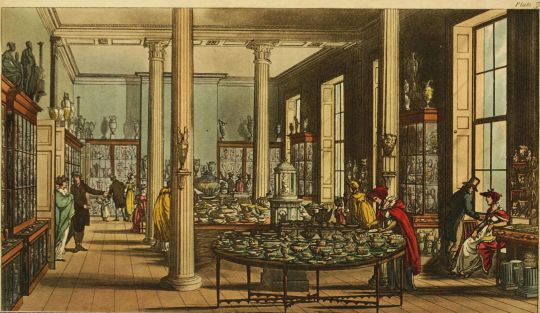
In 1774 Josiah Wedgwood and his longtime business partner, Thomas Bentley, opened a new warehouse, enamelling rooms and most handsome showrooms at 12-13 Greek Street, Soho. In 1795, after Josiah’s death, the Wedgwood studio moved to 8 St. James’s Square and the buildings were later occupied by coachmakers, writers and other artists.
Now, through Word of God we already know that Aziraphale spend the 1600s using his personal savings to gradually buy out portions of the neighboring land in order to build the original bookshop “on Greek Street just off Old Compton”, which finally opened in its current form in 1800.
This means that for the time Josiah’s company operated in Soho, they were at least neighbors.
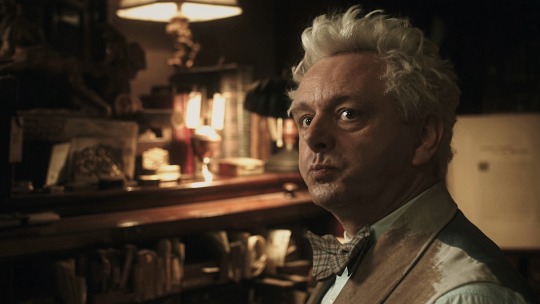
546 notes
·
View notes
Text
OMG
Did people know that Neil dubbed one line in S2?
I just got to the Hellsite™ in October so I have no idea if this has been discussed or not. Did we know Neil Gaiman overdubbed David Tennant for one word during the apology dance? No? Yes? Because he did. Sound up, headphones on please.
194 notes
·
View notes
Text
Keep thing about what does the Dirty Donkey present. How could I forget it appears as a mount in biblical stories. Love this theory and glad to know more about Jane Austen's story!
Inside the Dirty Donkey
**Warning! This meta contains spoilers and speculation for S3. Do NOT tag Neil!**
Time to get comfy, folks. Get your drink of choice, be it a cupperty, coffee, or nip of sherry, and find a seat. You’ll definitely want to be sitting down for this one. We’re going to the pub!
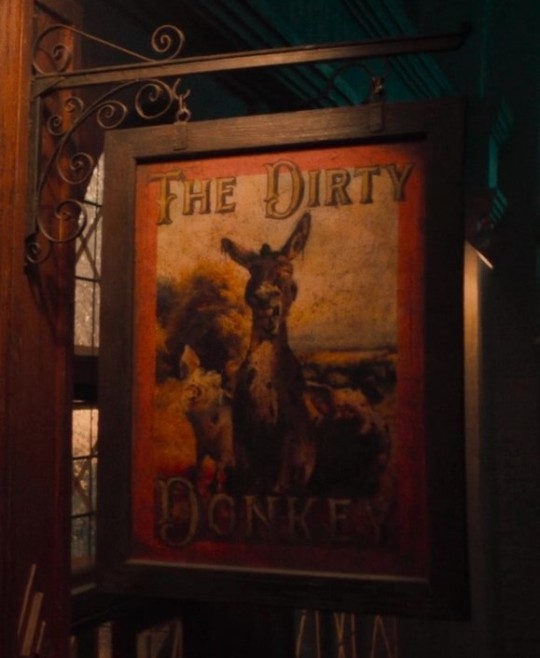


The name is apparently a favorite of NG’s, used in his short story “We Can Get Them For You Wholesale.” And it also appears in the Sandman AU.

In the short story above the protagonist is a jilted lover who tries to organize an assassin for his fiancé who is having an affair with another man at their shared workplace. He meets the ‘salesman’ of the firm he contacts at a pub called the Dirty Donkey, and it escalates from there. The story is freely available online, so you can search it up if you really want to read it, it won’t take long. It mentions a pale horse, which is usually what Death rides in on, and is appropriate in the context of that story.

The question we need to ask is how does the name The Dirty Donkey apply to the Good Omens AU? Are there any context to the name at all?
There are several meanings for a dirty donkey:
Its a slang or joke name for a black horse (not particularly a dark horse, that has a different meaning altogether)
A cocktail
A sex position (I’ll let you look that one up yourself…)
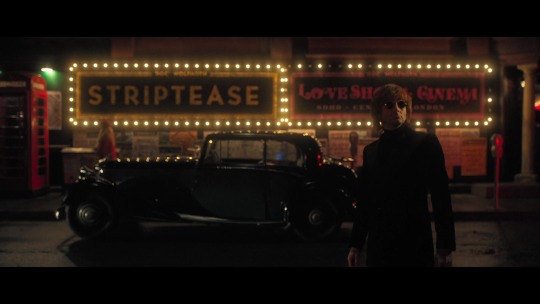
Probably the first thing we need to talk about, though is an actual donkey itself, in relation to Jesus, as S2 is full of Jesus references and hints to the Second Coming in S3. Yep, it was all there in front of us, but we were too focused on other things. If you remember your Bible teachings, Jesus rode into Jerusalem on a donkey, because he came in peace. In ancient times leaders rode horses if they went to war, or if they came in conquest. But arriving by donkey meant you came with peaceful intentions.
But Jesus didn't turn up in S2, you say. And certainly not on any hairy beast. Ah, but he did - metaphorically. Gabriel as Jim turned up - he came up the street, by (the Dirty) Donkey, walking through spilled blood tomatoes, then mentioned his arms were no longer sore (because he had been taken off the cross.) MrPeriod talks more about how Jim represents Jesus here, and it might be worth revisiting it at length another time, as there is quite a bit to unpack there.
There are also the two big golden lions perched on either end of the bar inside the pub, that look rather ominous. The lions are strongly connected to Jesus and his resurrection, representing his return. (I'm still planning to have a better look for more lions in both S1 and S2, but that is still a WIP at the moment.)
There is also the scene in 1941 where the Nazi zombies stagger into the Dirty Donkey and spy on Aziraphale and Crowley through the windows through to the book shop, but all they manage to get is “Banana, fish, gorilla, shoe lace with a dash of nutmeg.” It sounds a bit like a cocktail reference – well, the nutmeg is definitely a GO ref to a certain cocktail – but the cocktail called a Dirty Donkey has cinnamon in it, in the form of cinnamon schnapps, not nutmeg – plus chocolate liqueur and rum. So maybe not.
But perhaps the most important thing we have to examine is the conversation about Jane Austin that Aziraphale and Crowley have in the pub, in S2E2. Because its got so many levels you just about need a break for extra oxygen half way down. Ha! And you thought it was a couple of funny throw-away lines about how Aziraphale saw human romance...
OK, this is the section of dialogue we are going to look at:
AZIRAPHALE: If you're going to invoke fiction, you might as well do it properly. CROWLEY: Properly? AZIRAPHALE: You remember Jane Austen? CROWLEY: Yeah. I'm not gonna forget her in a hurry, am I? The brains behind the 1810 Clerkenwell Diamond Robbery. Brandy smuggler. Master spy. What a piece of work. AZIRAPHALE: She wrote books. Novels. CROWLEY: Jane? Austen? AZIRAPHALE: Yes! CROWLEY: Whoa, bit of a dark horse. Novels, eh? AZIRAPHALE: Yes. They were very good. CROWLEY: Well. No, I'm just surprised, that's all. You think you know someone. AZIRAPHALE: She had balls. CROWLEY: Well.... AZIRAPHALE: Cotillion balls. People would gather and do some formal dancing and then realize they had misunderstood each other and were actually deeply in love.
Ready to dive into the levels on the Jane Austen conversation? Let's go...
Level 1: It’s a conversation about the novelist Jane Austen, and it sounds like they both met her, but they remember her in different ways – and Crowley’s memory is rather surprising!
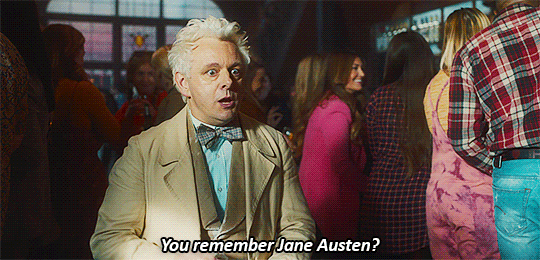
Level 2: There is a mention of a robbery. This makes the parallel with the 1967 scene in S1E3 Hard Times, where Crowley has a secret meeting in the Dirty Donkey to plan a robbery to steal holy water from a church. The robbery in the above conversation involves diamonds (are you taking note/s? This is important!) from Clerkenwell, a district of London of some notoriety. It was famous for it watchmakers and jewelers, but it was also the home of Oliver Cromwell, who has a link to the 1650 date mentioned in S2E1 and the Eccles cakes, to Charles Dickens (author of A Tale of Two Cities, a book of note for GO) Oh, and both times Crowley is wearing a "Tactical Turtleneck", which others have noted he wears when he is doing his own master spy work, such planning or discussing robberies, or sneaking into Heaven to rob them of information!
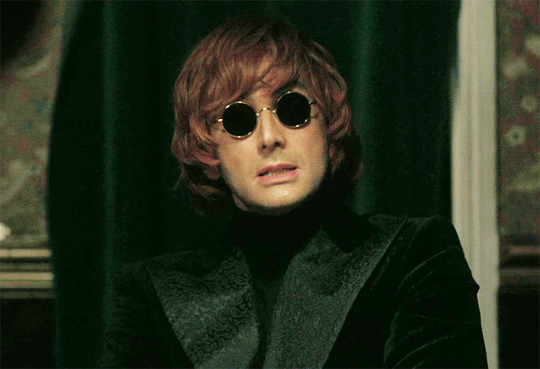

Level 3: There is Aziraphale’s idea about how a romance should be conducted, by hosting a cotillion ball with formal dancing, because he's read all those romantic novels by Austen. And we get to see that played out in S2E5 in the eldritch ball. Crowley's idea of a romance was to get caught in the rain and kiss, then - vavoom!

Level 4: Why mention this apparently fictional side to an author of fictional romance? Well, on one hand, it’s an interesting but dark set-up for a joke later at the beginning of S2E6. I ended up discussing it at length here, but the short of it is that it is our usual human custom not to speak ill of the dead, and this is a form of extreme black-and-white thinking. Here, Aziraphale speaks of the good/white side of Jane Austen, that is well known, but Crowley speaks of the black/supposedly forgotten or unspoken bad side of Austen.

Level 5: Here’s the S3 information. Have you been paying attention? Did you take note? The parallels were the robberies between a church, and diamonds? That she was a brandy smuggler? Do you know where they smuggled brandy from? And do you know where Austen actually lived? On the South Downs, overlooking the Channel to France…
Whew. I think I need a drink after that. Cheers!
69 notes
·
View notes
Text
好兆头S2隐藏剧情之好大儿去哪(中文补档)

著名的魔术理论已经提到了S2许多不对劲之处,有一些情节被刻意地设置得不引人注目,像水从鸭子身边悄悄流过。但魔术理论的缺陷在于,它将整个剧本设置为虚无。解谜的关键在于要有实际意义,发现一个谜题之后把所有的内容都套入谜题而把故事拆得分崩离析,甚至虚无故事本身的意义,就已经陷入了谬误。
先简短地说一下我的结论:S2通过将一部分剧情设置成视线盲点,在主线之下,讲述了一条基督复活的暗线。没错,正如花絮中讲到的,本季对于第三季内容不只是提示性的添加彩蛋,而是真真正正在观众眼皮底下,基督复活已经在悄悄发生。所以我说,第二季就好像是尼尔盖曼冲进亚马逊高层的办公室,把剧本摔在高管的办公桌上咆哮:
"GIVE ME SEASON 3 OR GIVE ME DEATH!!"
在推理之前,先要明确几个推理的方向。
首先,根据S1身体交换的剧情,202蛇救山羊的剧情等许多明显的对照可以看出,如果某个情节真的是线索,那必然会存在一个非常明显的答案,虽然没想到的时候可能毫无联系,但是一旦发现其中的联系就会非常明显。所有镜头对焦的地方能找到的信息都可能有用。但就像魔术理论犯的错误,为了自圆其说自己开始编情节甚至为此扭曲原本剧情的连贯性是不行的。
其次,S2的剧情线非常多。有明面上的三条感情线,Jim的基督复活暗线,结尾的梅的暗线,以及用来解释整个剧本逻辑的双线程主线框架。而同时,贴心的剧组还埋了大量的彩蛋,比如音乐商店Tardis的BGM,这种就当个粉丝福利看过就过去;但也有一些彩蛋不仅仅是彩蛋,和剧情和暗线都是有关联的。典型的参见我对闪电战小剧场的分析:盒子里的剧本书看似是致敬原文,做了两本道具书和一封信,但应当注意到其中一本书只出现在原著的脚注,如果为了致敬,大可以把四本虚构的剧本都展示一下。并且通过了解镜头展示的两部剧的原型剧情,提及了接子弹(箭)和跳舞女郎,则可以清晰地定位到闪电战小剧场,而一封注明给鞋匠的遗赠信则正说明盒子里的小剧场是天使留给蛇的线索。这种彩蛋就是可以作为线索使用的。
那么在接受这些前提之后,我们开始推理吧。
首先,我们需要质问自己:有一个人物,拥有单人海报,拥有宣传短片,贯穿剧情始终,但在结尾,所有人都遗忘了ta。尼娜和玛吉都有一句告别性的台词("永远再见了"),别西卜都知道给天使道一句谢,而这个绝对的S2主角却再没有人提一句。
Jim去哪了?
在加百列恢复记忆后,整个S2两个主角和Jim建立的友谊瞬间烟消云散,谁都没有提一句。这种头重脚轻的感觉被随后的重头戏冲散,让人无暇去想。实际上这是很不自然的,因为明显剧情里给了两个主角和Jim完整的关系弧线。有蛇最后别别扭扭终于给Jim冲了巧克力;有天使对着Jim坚定地表示一定会保护他;还有在开头特意说的我有了两个朋友。很明显,当加百列一恢复记忆,天使立刻变得看上去想把他按到圣水里人道毁灭,半点没有相处六集的感情。就像久未落下的第二只鞋子,关于Jim的故事还远没有结束。
以上是论证Jim和加百列实际上是两个人物,也就是暗线存在的合理性。然后是关键的问题:
Jim是谁?
S1的特效设计在展示耶稣受难时,用一块红布来代替表现血水,而在S2,他们显然找到了更省钱(考虑到物价可能更贵)的办法。
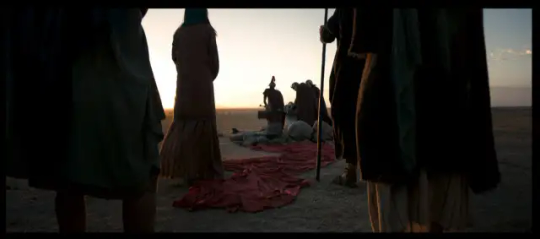
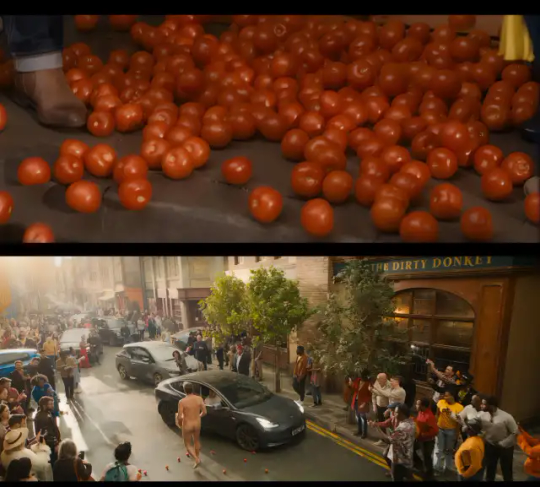
这一地的西红柿。花絮视频的放出让这条线索更明显,因为被删除的剧情是合理化这堆番茄被撒出来的原因,那么在紧张的分钟数限制中,删掉了碰翻番茄的原因,但仍留下了这个突兀的镜头,原因很明显:It's a CLUE。
基督受难被刺中肋下流血,双手被钉导致手疼,被士兵逼迫喝没药/苦胆。我们的Jim则幸运得多,胳膊也不疼了,还有温暖的热可可喝。
发现这条暗线之后才发现片中对Jim身份的暗示如此之多。这也是证明对暗线剧情的推测不是我的妄想。
首先是服装。除掉在书店的日常造型,我们来看下其他几个Jim的造型:
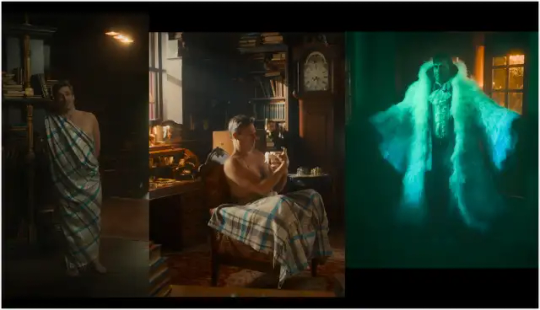
注意看图三Jim布道的姿势以及整个造型形成的十字架形状。我们再来看一些宗教画中的基督形象:
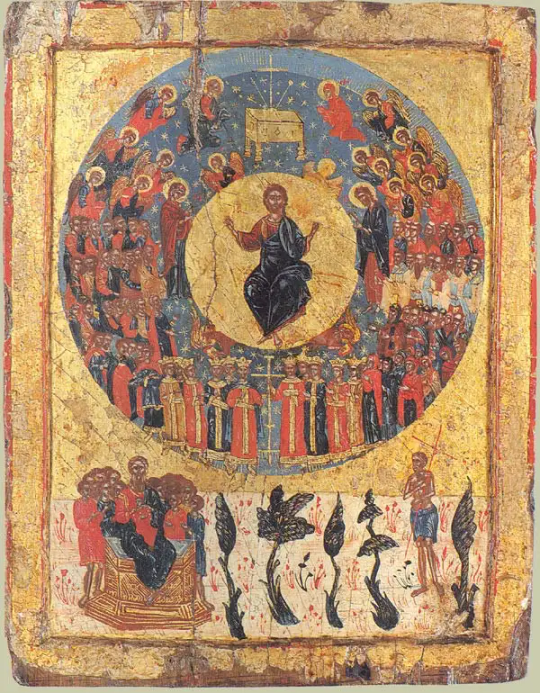
注意看衣着和姿势。以及右下角这个熟悉的持十字架的姿势,虽然大部分经文认为有另一个人在受难路上帮耶稣扛十字架,但是也有比如《约翰福音》中认为是基督本人扛着十字架。这个眼熟的姿势对应了剧情里另一条灯下黑的线索,就是看似无功而返的爱丁堡之旅的主题:神秘的加百列雕像。
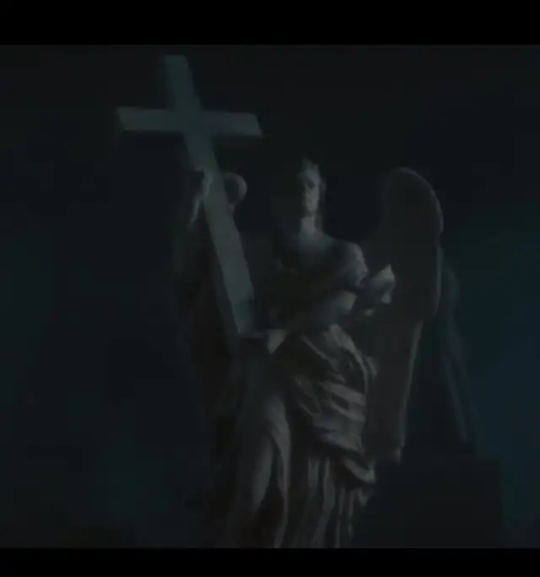
换而言之,我们可以说,这根本不是加百列的雕像,而是Jim的雕像。
牵强吗?实际上,S2展示过一副关于基督的图像:
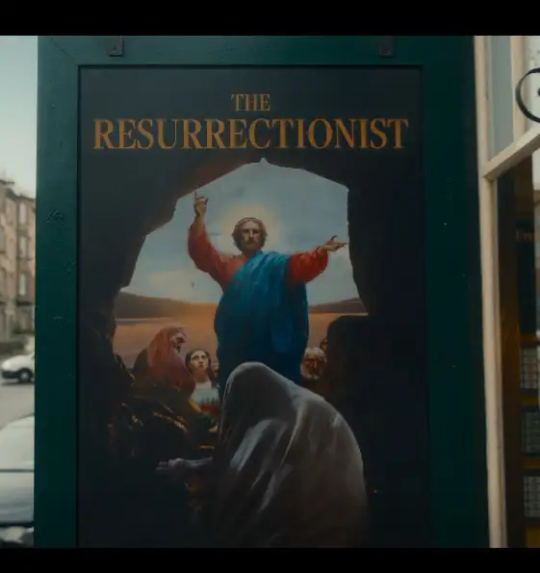
这个相似的服装,我认为对Jim身份的对应已经很明显了。顺带一提,在圣周耶稣还要清洁圣殿,还记得那个可可爱爱的鸡毛掸子吗?我特别喜欢这个玩笑,因为当天Crowley真的被赶出了书店。
实际上,我们还有更明显的提示,那就是简奥斯汀的舞会。在舞会上,大家都在跳舞,而好大儿在干嘛?
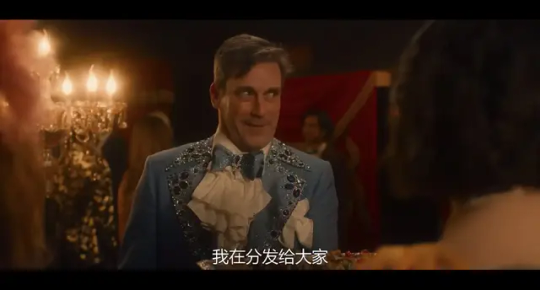
他在分发肉馅饼。这里对于最后的晚宴的暗示如此之明显,成为了我对于Jim暗线最有力的证据。
一些其他的细节支持:
关于“7”的密码:Jim在玩台灯和自己的嘴巴时展示了一个节奏:— — ---
两长三短,这是摩斯电码的数字7。还记得上帝有多喜欢7吗?耶稣在宗教上是神子,在《约翰福音》中耶稣被认为是神道(Logos)的化身,他不仅说神的话语,而且就是神的话语。这条线索的发现是因为我在拉片的时候感觉晚宴上Jim玩自己身体的情节,作为一个黄色笑话实在太长了,而最终发现他玩自己的身体是有节奏的,而这节奏和他玩台灯的节奏一模一样。S2真的没有废笔。
还有一个关于Jim和上帝的暗示是他丢下的书:
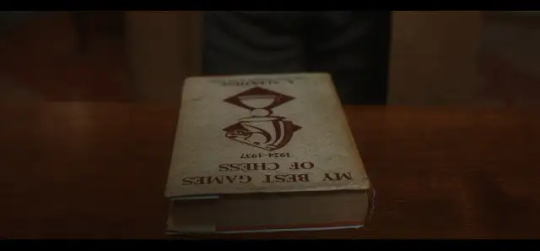
《我最好的棋局》本身是对电影《平步青云》的致敬。但联系我将在下文提到的上帝在上司组的故事中摆弄的不可言喻的棋局,以及S2放在天使书店里一直没有用过的象棋。这一切都暗示了世事的发展受到不可言喻的操纵。而在这里,Jim丢下了这本书,抱怨东西没有摆到他放的地方。这是一个明显的上帝视角的抱怨。同时也又一次强调了本书的主旨。
以及来自LOFTER用户@ClueFell.的补充:Jim在书店里用只属于他自己的方式排列书籍,这也是一个���似上帝的行为。
《马太福音 4:1-11》描述了耶稣在旷野遭受魔鬼的三个试探,其中一个是为祂展示万国的荣耀,这是蛇在103的工作。另一个试探是让耶稣从圣殿的顶峰跳下去,是蛇在205的工作。蛇蛇真的累了,偌大的地狱只有他一个人在996,换我我也辞职。
以及,我们细想Jim给出的预言:
第一句:"我记得晨星齐声歌唱,上帝的一众天使欢呼雀跃。"出自约伯记,但在剧情中可以看到这句话是上帝本人说的。
第三句:"如果它再次发生,将是体制的问题。"后面我们得知这句话是梅塔特隆说的,而梅塔特隆是上帝之声。
而第二句:"暴风雨将会到来,黑暗降临。已死之人将走出坟墓,再次行于世上。"前半句出自《希伯来书12:18》,描述上帝降下的不祥的征兆。后半句出自《马太福音27:53》描述了耶稣死后发生的事情。而且这句话也一唯一一句加百列本人没有听到的预言,是对Jim不是Gabriel而是耶稣的佐证。
可以看到,这些话语大部分都与上帝和耶稣有关,这些预言虽然在主线中都有剧情对应,但连在一起,则是对耶稣复活的暗示。
这里还有一条线索,并且在最新的彩蛋中被强调。S2给出了使一个人死而复生的奇迹力量的单位:Lazarii。彩蛋中提到了这个词的原型Lazarus:伯大尼的拉撒路,在死后四天被耶稣复活。该奇迹是基督受难前最后一个奇迹,也是最重要的一个奇迹,因为它意味着基督终于战胜了最后的敌人:死亡。
而在S2中,Jim到来的那天是星期天,因为尼娜提到了一切开始于上星期的停电。而舞会举行在星期四晚上。所以加百列在周日死去,四天后被复活,对应了拉撒路复活的情节。而隐藏Jim的"微小"奇迹需要使拉撒路复活25次的力量,除了基督本人也难以解释为什么这件事情消耗如此大。(25这个数字不知道有没有含义,如果解出来了我再补在这里。)而最后Jim消失的星期五正是耶稣受难日。
一些关于Coming的线索:
Jim一直说他是来寻找亚茨拉斐尔的,但加百列正在寻找的是别西卜。
以及一些关于coming的台词:
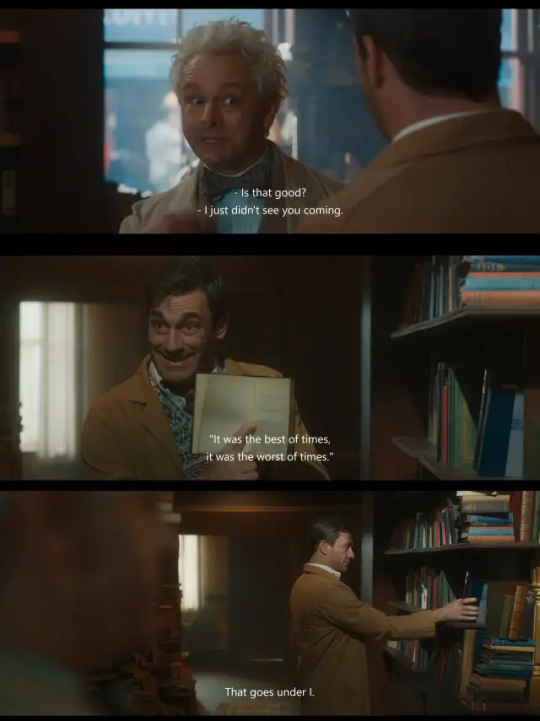
解开了Jim的隐藏身份后,这个“I”看着真是让人细思恐极。
S2的书店场景和圣詹姆斯公园的第一个镜头都是直接从S1复制来的,且不说这其中的意义是什么,S1书店的开场意味着上帝视角,但在S2:
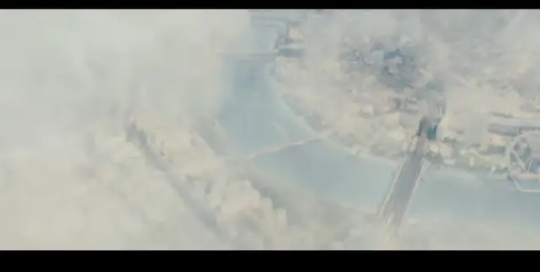
"他们要看见人子带着能力和大荣耀,驾着天上的云降临。"《马太福音24:30》
神从天上/云间降落,也有观点认为会伴随天使和号角,我们在第二集米迦勒他们来的时候听到了号角声。再来看几张海报和剧情截图。
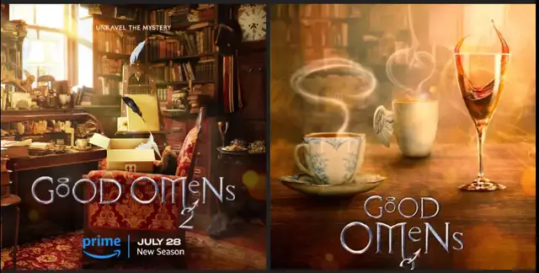
代表Jim的羽毛从天而降,Jim的杯子里不仅有代表加百列故事的爱心,还有从上方降下的一条烟雾。
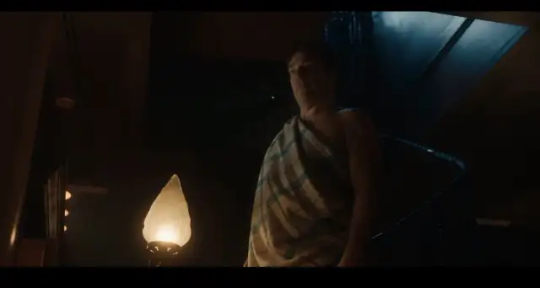
以及这个明显的Jim从上往下走的镜头,还有前面的羽毛大衣剧情中,Jim的自愿献身。
还有虽然和coming无关,但和Jim身份有关的海报:
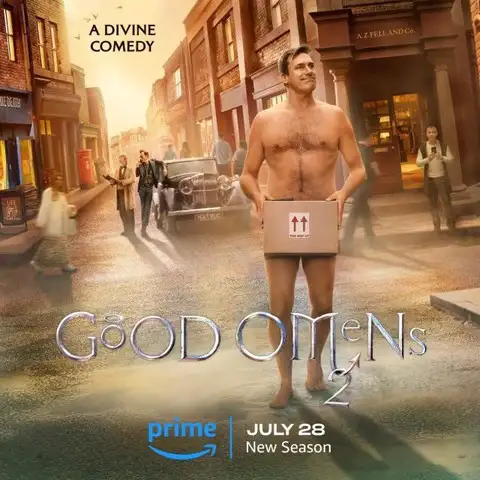
神行于水上。(图来自汤@thesherrinfordfacility)
关于音乐的线索:
上司组的故事里有一些关于不可言喻的线索。请看在不同背景里玩扑克下象棋的两位老人家:
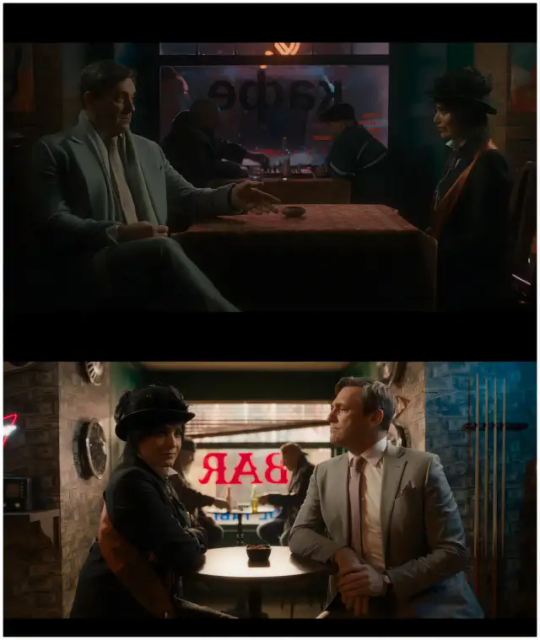
这些截图表明,上司组的故事开始于在上帝���可言喻的操纵。而在第二张截图中,当他们相爱时,我们可以听到《Every Day》的BGM ,可以说这正是上帝在演奏这首关于世界末日的歌曲。而向加百列解释这首曲子时,别西卜说:

这似乎意味着每一集片尾主题中插入的《Every Day》可能包含着线索。但我缺乏音乐知识,所以这个谜题不归我解。而当亚茨拉斐尔问Jim这首神秘的歌曲来自哪里时,他回答:
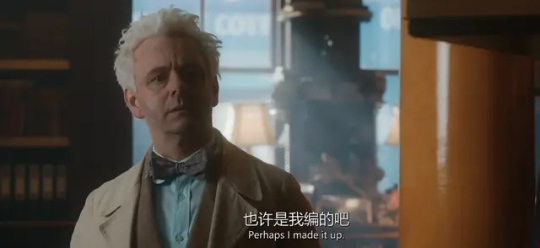
以及一个最好玩的暗示。加百列走丢了,梅塔特隆只说找回来就好了,但是隐藏加百列却会被抹掉,并且隐藏加百列的奇迹直接就会拉响警报。可见重要的不是加百列,而是Jim。
这就是解谜游戏的的乐趣,当发现答案后才会发现,剧情里的线索如此之多,就像前往糖果屋的饼干屑。
到这里,Jim的暗线已经写得差不多了。亚兹拉斐尔和克劳利联手释放的奇迹效果好得吓人,连观众都不再注意到Jim的存在。在故事的最后,他们达到了最初的目的,Jim悄悄地消失了,天堂、地狱、人间以及电视机前的观众,谁都没有注意。
那么,Jim的暗线的作用是什么,或者说,是谁要把Jim藏起来?为什么?又为什么设置这些线索,希望谁能发现?
写在前面,这往下将开始出现许多的未完善的推理,因为缺乏决定性的证据。只是作为我个人对剧情结构的解析放在这里。
首先,根据上文的叙述,我们知道了在看似甜甜的爱情故事下,S2实际上和S1一样,都笼罩在末日来临的阴影中。那么,S2到底是谁在讲故事,又是谁在听故事呢?
有一个人形生物,在想隐藏想法时就会习惯性扯淡,比如他在被天使同事围殴的时候,扯出了一大堆关于立场的废话,又比如他在想忽悠男朋友做他不愿意做的事情时,用大量的主观叙述和插科打诨把来自梅塔特隆的威胁描述成了美好的愿景。没错,如果有一个人,想要隐藏Jim的存在,而在叙述S2的经历中,巧妙地误导观众将注意力放在爱情故事上,除了伟大的瞒过娜芙蒂蒂的魔术师 Mr.Fell 再无他人。正如他在闪电战小剧场中展示的硬币魔术一样,一分钱就这样消失了。亚兹拉斐尔的魔术技巧如此精妙,在后面将照片(证据)替换为传单中又着重表现了一次。
《约伯记》的书是亚兹拉斐尔展示的,爱丁堡的小剧场直接是天使的日记,以及在舞会结束后,尼娜询问亚兹拉斐尔这一切从什么时候开始,他给的回答:
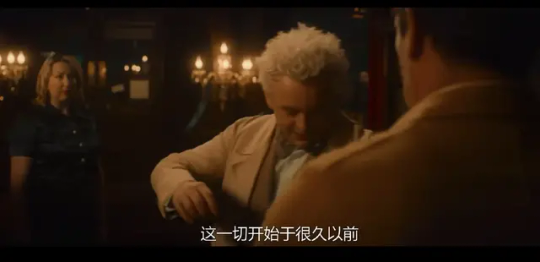
他已经解出来了。可惜后面的事情一件接着一件,他和克劳利再也没有机会沟通,最终向着不同的方向开始下一段旅程。
整个S2就像亚兹拉斐尔的侦探小游戏剪报,在时间线性叙事中贴了几张他认为有关的线索。
而闪电战小电影,则是他在完成这场精彩的魔术表演后,留给观看者的线索。这个线索被放在盒子中,展示完盒子里的物品特意给了亚兹拉斐尔一个查看的镜头,这物品是避免糟糕的事情发生的关键。这个小剧场本身可以看作处于这部三幕剧的正中,而时长上,那段绳子魔术则位于204的正中间。具体情节不再赘述,只提一句,当尼尔写下第三季的剧情时一定非常得意,以至于他在魔术店剧情中写道:"这将会是我的镇场之作。"而考虑到这个魔术是亚兹拉斐尔选择的,也有可能其在第三季对应的情节是特里想出来的,而尼尔则怀着对老朋友的无限怀念和钦佩,写下了这句台词。闪电战小剧场体现了两个人相互信任和合作的重要性,又反复强调了亚兹拉斐尔的魔术手法。以及在正中间位置完整展示的绳子魔术。(尼尔转发了扮演魔术师的演员演示该魔术的推,这一段剧情绝对很重要!)
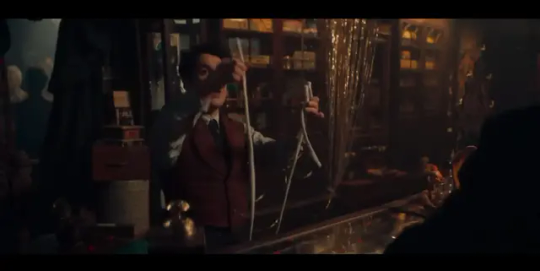
这里的画面近乎刻意地拍到了镜中的亚兹拉斐尔,这个经典的镜头语言意味着这里实际的叙述者正是镜中的亚兹拉斐尔本人,他正在骄傲的展示他是如何通过几条故事线在S2巧妙地隐藏起所有的线索,以及通过闪电战小剧场暗示整个三季大事件的进行。
在S1的闪回之后,亚兹拉斐尔为了弥补克劳利的过失,作为新手魔术师(差劲的大天使)代替被当作逃兵抓走的前魔术师(加百列),站上天使们的舞台(亚兹拉斐尔在魔术登台时的开场白中称跳舞女郎为“Bees knees”,而除此之外S2唯一提到蜜蜂的一处就是206克劳利上天堂时称天使们为蜜蜂。),台下坐着和人类呆在一起(停留在地球)的克劳利,作为后藏着来自地狱的恶魔和他们雇佣的死而复活的僵尸。S2的剧情进行到亚兹拉斐尔邀请蛇上台当他的副手但蛇没有立刻搭理他 。
这里插一句,这并不意味着整个闪电战剧情都是虚构的,应该说,所有S2的小剧场的确类似于讲述的一段故事,但是是在真实的故事的基础上,添加了一些线索。所以对小剧场的解读应该是挖掘其中不自然的地方作为线索,而整个故事则是真实发生过的经历。哪怕像闪电战小剧场这样梦境般的诡叙,依旧是建立在许多实际发生过的历史碎片上的。
那么,S2的故事为何要设置的这么错综复杂,闪电战这个暗藏玄机的小剧场又是写给谁看的呢?
他还能写给谁看,谁会让亚兹拉斐尔交付全部的秘密,谁会被亚兹拉斐尔托付他的后背他的性命,又是谁需要亚兹拉斐尔瞒过上帝传递出情报,来共同拯救世界于末日?
不知道有没有人注意到,片头曲里有一个很古怪的场景,那就是最后的剧院。虽然魔术理论把大家的注意力都引导了幕布可能代表的生命之书上(这个说法可能有部分道理,但我仍在完善这部分猜测),但大家都忽视了,闪电战的风车剧场在前面已经展示过了。
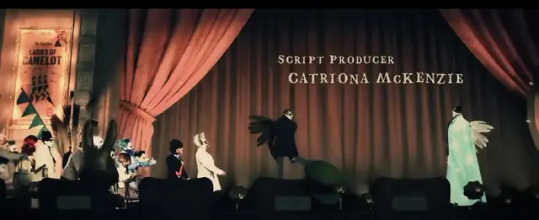
而有幕布的地方,是另一个剧院,或者说,一个放映厅。
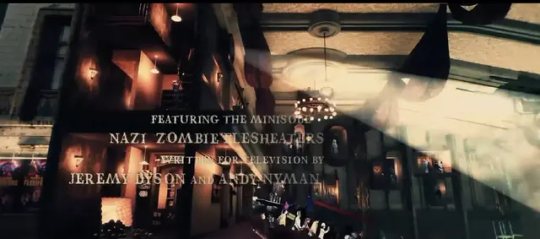
纵观整个S2,根本没有出现过这个场景。片头曲中几个没有出现的场景,一个是最后的圣山,是对Jim线一个明显的暗示。开头的隧道和我没有在这篇讲述的生命之书的可能假说有关,有兴趣可以去lof或者汤上看全文。而剩下的这个根本没出现过的放映厅......
等一下,有一个放映厅不是吗?
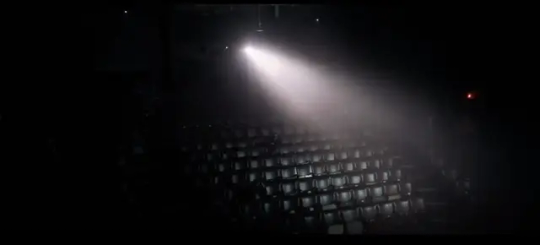
这是好兆头宇宙出现过的唯一一个放映厅。这种车站边的放映厅在现在早就没有了,但尼尔对此有一个浪漫的解释:因为克劳利喜欢,所以亚兹拉斐尔为他奇迹般地保留了一个。在片头曲中还可以看到克劳利在S1中吃的爆米花,而X-Ray视频还提到了爆米花盒里有一些圣餐薄饼。
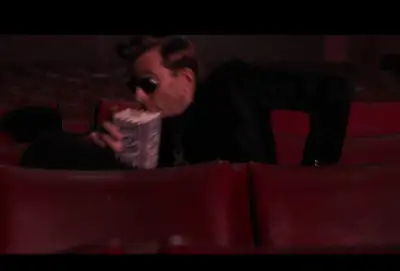
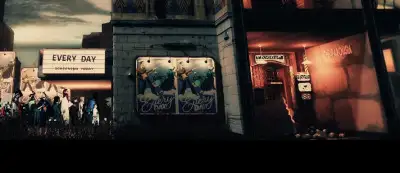
X-Ray视频还给了这个想法一个支持性的线索,那就是放映厅侧面前上的人物许多来自第一季,这是一个彩蛋,但也可能是暗示这个场景应该回第一季寻找线索。
而且我们都知道,克劳利来这里自闭看动画片,正是在凉亭分手之后,尼尔的Q&A中提到他心烦意乱需要找个地方冷静一下。也难怪大家被刀得死去活来他却把S2的结局类比为凉亭分手。
那么以下就是讲故事时间:
S2是克劳利在离开后躲在放映厅里,细细回看这一切混乱发生的过程,我相信就像观众也觉得亚兹拉斐尔不爱克劳利就像杨先生会放弃保养他的汽车一样可笑,克劳利在S2结束后一定会觉得有哪里不对劲,会把回忆细细咀嚼,翻着亚兹拉斐尔留给他的滑稽的侦探小游戏手帐簿,最终投影出了我们看到的交织着两个人回忆的S2的故事。
而闪电战小剧场,则是亚兹拉斐尔留下的魔术说明手册,看似晦涩难懂,却把该做的事都写在里面了。就像S1在酒吧里哪怕意念交流也要留给蛇的预言书,他会不会来呢?可惜观众只有等到第三季才能知道了。
于我个人,我认为未来的剧情已经在烛光晚餐里说尽了。
终于写完了这篇巨长的分析。考虑到传播,抠掉了初版的几个还未完善线索的脑洞(生命之书、梅塔特隆的剧情等)。本来只是来看小甜剧的没想到还有解谜,真的是一下子就兴奋起来了。其实还许多谜题没有解开:梅给的咖啡——杏仁糖浆燕麦奶(OMLAS),Jim整理的那一排书(在看了在看了)。字谜对于非英语母语实在是太不友好了,更别提书本分析要结合书的内容。还有参考影片平步青云和音乐部分的解谜(感谢神曦老师!!!)。真心地希望等把这些谜题都解完,第三部会在前方等着我。
7 notes
·
View notes
Text
“echoes of reality across time loops”!I think you really got the point!
All the music you didn’t hear: The Good Omens soundtrack is lying to you. *Part3*
The Bonkers Meta Series 2: Electric Boogaloo.
Part 1 l Part 2 l Part 3
Remember way back in Part 1 of this series where I said there's a missing track in the middle of disc 2, track 7 on the album? My thought was, "It's not on the album because it's supposed to be a pre-recorded song! Just like queen and the rest. I'll search through all the versions of A Nightingale Sang In Berkeley Square, because that was released in 1940. One of them has to be 1:03 seconds long, and that'll split the track Zombie dressing room in two!" Well, after searching through at least 10 recorded versions of that song, I can tell you none of them fit.
I was about to hang my head in defeat when I realized, there's another version of A Nightingale Sang In Berkeley Square that is technically *part of another song*, and therefore wouldn't get it's own credit on the album. And it's about a minute long. Wanna know which one? Sound on please.
Those are quite the magic words, Aziraphale.
703 notes
·
View notes
Note
Same to me
Hey Neil,
Just a silly question about the writing process. You said that you’re a part of all your characters, and that got me thinking.
When you’re writing/editing/rereading do you ever act out what the characters are doing? Like pull a funny face when a character does the same? Or do you ever talk out a conversation in two different voices?
Just curious!
I don't normally talk out loud if it's just me.
But I'm doing all the characters' facial expressions whether I'm aware of it or not, which is one reason I try not to write in public.
3K notes
·
View notes
Text
Love this! I’m also keep thing if there is a King Arthur story in S2. Considering this was a holy grail story in S1.
Once and Future Royalty
Just, stay with me on this one. I know its going to look crazy at the start, but trust me, I know where I'm going.

It all started with the 537AD scene in Wessex in the opening montage of "Hard Times," S1E3. Yeah, the one where Aziraphale is supposed to be a knight of the Round Table and Crowley is role-playing the Black Knight, and they are both so super-squeaky shiny clean - not a speck of dirt or mud on them. wtf! It looks out of place, unrealistic, and was bugging the crap out of me, like a stone in your shoe. It just didn't fit. I mean, why put a myth, a legend, into that sequence? Oh, OK, yeah, the preceding stories from the Bible, like the Garden of Eden and the Flood, aren't "myths" as well, you say? Hmm. In the context of the Good Omens AU, being a biblical based story, they belong there far more than the legend of King Arthur.
King Arthur, who supposedly united Britain under his rule during the late 5th century and early 6th century, was shown to have the divine right to rule by wielding the mighty sword Excalibur. Some stories tell of Arthur pulling Excalibur from a stone. Some tell of him receiving Excalibur from the Lady of the Lake. Either way, it was bestowed upon him by divine grace. Despite his triumph in battle, he left no heirs, as his queen, the fair Guinevere, was barren. She had a long-running love affair with the greatest knight of the court, Sir Lancelot, but despite this being an open secret in court Arthur would not put her aside. The knights of the Round Table in the court of Camelot were near-paragons of Christian virtue, and there are many tales of their search for the Holy Grail, the cup from the Last Supper of Jesus Christ.
In the end, mortally wounded in battle, Arthur was taken away for healing, and never seen again. It was said he would return when Britain was at it most direst hour to save the day once more. A "messianic" return.
The Once and Future King.
Now, I'm no Arthurian novice; I drank up all of T. H. White as a teenager, read the Dark is Rising multiple times, Marion Zimmer Bradley's interpretation and what ever else I could lay my hands on for a good couple of decades. And there is LOTS of King Arthur stuff around. You are not left wanting for anything new to read or consume. And I'll bet there are a fair few of you also out there who know a quite bit about the legend as well. Oh, and I can't tell you how many times I have watched Monty Python and the Holy Grail. I still walk around quoting it day-to-day, like the good little Gen-Xer I am, having grown up on that stuff. So I really should have listened to my intuition when bits of Monty Python kept popping up in my brain in response to other parts of GO I was thinking about. (Staaay, I said, stay with me here....)

I kept chewing away furiously on the Wessex problem, growling in feral frustration at it, but also kept reading and sorting out some other ideas and metas at the same time. Eventually I found the key in a tiny little post, about a small detail in the 1941 Blitz episode S2E4, of all places. I wanted to slap myself with how much was staring me in the face so obviously once the door opened. And the damn beauty of it is, that I already written about some it, out of context, without knowing the why.
OK. Where to start this journey...hmmm, back to Monty Python, because, guess what - the Wessex scene is actually riffing off one the more famous skits out the the Holy Grail. The scene is a masterpiece of political satire, from start to finish, but the relevant part here is this sequence:

In case you missed the salient points: Arthur claims he is king by divine providence, because he was given Excalibur by the Lady of the Lake. Dennis the peasant protests this waterlogged method of determination, mentioning ponds, watery tarts and a moistened... well, I hope you get the idea about where this is going.
Meanwhile, in 537AD, Wessex, as the mist swirls around them:
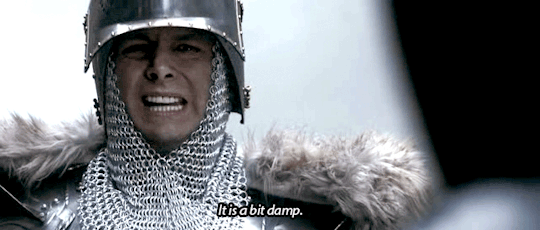
"It is a bit damp," complains a shiny silver Aziraphale.
Yes, Excalibur would be a bit damp after it emerged from the Lake. (vidavalor! Get your mind out of the gutter! I'm trying to have a serious discussion here! Please! And I wasn't even going to go anywhere near what the sword in the stone is really meant to be referring to...it's not even relevant to the discussion at hand, I swear! Well, there is going to be sexual relations mentioned but - oh, never mind...)
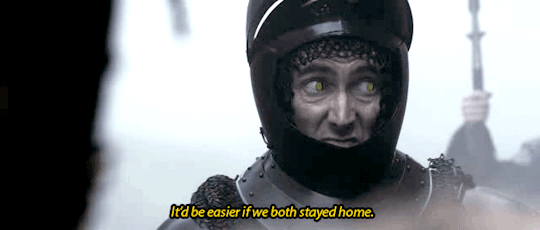
Right. Where were we. Lets leave those super-clean elite pretendy knights to swim off through the swirling mist back to their dry homes to write and file reports to head office, along with Patsy and the hired Igors, and Dennis can keep playing in his lovely muddy filth after he finishes protesting being repressed by the divinely-deluded Arthur. I've got a bit more to say about what Aziraphale and Crowley might represent here later but you need some more context first, so lets move on. I just needed to show you the first bit so you can see the Arthurian theme stretches across both S1 and S2, and will likely appear in S3 as well. More about that towards the end.
Ah, before I forget...another ref from the Holy Grail we need to cover:

This GIF, unfortunately, doesn't have the full exchange between the peasants, which is this:
P1: "Who's that then?" P2: "I don't know. Must be a king." P1: "How can you tell?" P2: "Because he doesn't have any shit on him."
Ah. Er. OH!
Have you made the connection?
Who have I been emphasizing as being unusually clean in their Arthurian setting? That's right, Aziraphale and Crowley.
What's this implying? That they are royalty. Celestial royalty. Maybe not kings, but how about princes? You know how we've been discussing whether Crowley was a once at least an Archangel, and there is even a hint that he was a fallen prince of Heaven given during the replay of Gabriel's trial? (Not the prince, but a prince - a seraphim) And that Aziraphale may have once been Raphael, and may be again in the future? Once and future royalty. To me it adds weight to the past discussion, and helps to explain the assumed authority expressed in these two scenes here: On the left, Aziraphale takes control inside the book shop as the angels and demons argue who is going to punish Gabriel and Beelzebub (annoyed I couldn't find a suitable GIF for this) and on the right, Crowley is shouting at the assembling demons in the street that they are "out of order."

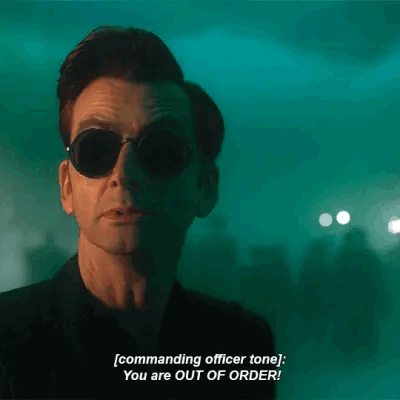
Onward, Patsy. (I hope you're still with me.)
1941, the Blitz part 2, minisode.
We've found Excalibur! On to Camelot!
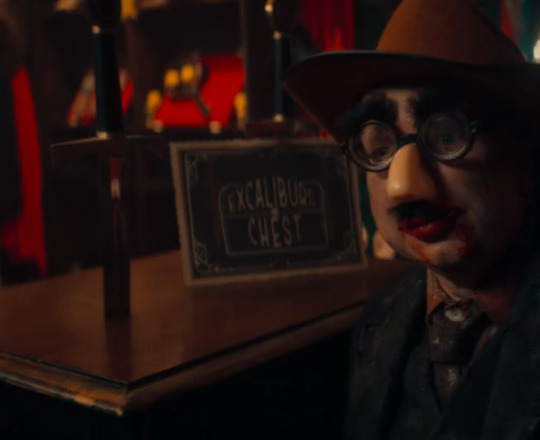
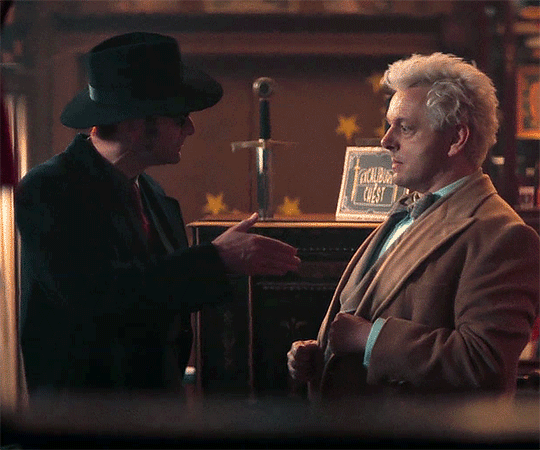





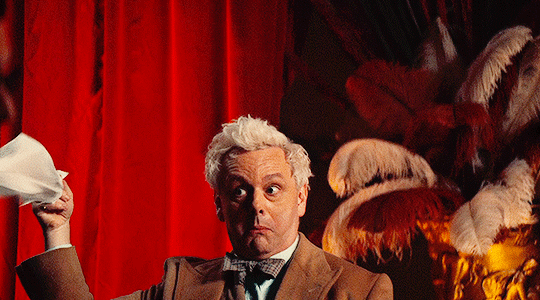
Camelot was King Arthur's castle and home of his court. In S2 of GO the Windmill Theater is established as our court of Camelot where our 1941 Blitz-era Arthurian drama is to play out, involving Furfur and the zombies.

Yes, poor old Furfur. Two's company, three's a crowd, as they say. Now we know we're in Camelot, we need to be reminded of the central tragedy of the Arthurian story, that ultimately led to the golden kingdom's fall. Lady Guinevere, Arthur's queen, famously loved Sir Lancelot, and the two were passionate lovers. It was essentially a love-triangle at the top, with Arthur being jilted, but he wouldn't/couldn't discard his queen. Where do we see this playing out in 1941?
Furfur, pleased with himself for catching an angel and a demon in the act of consorting together (with the help of the zombies,) barges into the backstage dressing room, and confronts the lovers with their crime. But who is playing who in the Arthurian love triangle? I would say Furfur is clearly caught in the role of Arthur here. Consider the following exchange:
FURFUR: Hmm, well, well, well… What have we here? AZIRAPHALE: Sorry, have we met? FURFUR: Oh, no, you never had the pleasure, but… we have, haven't we? CROWLEY: Have we? FURFUR: What do you mean "have we?" You know we have. We were in the same legion. Just before the Fall. Doing dubious battle on the plains of Heaven. Remember? CROWLEY: I remember going into battle, I don't remember being there with you. Sorry. FURFUR: I was right next to you. We did loads together. You use to jump on me back, little monkey in the waistcoat. Anyway, whether you do or whether you don't, it doesn't matter. I'm here to inform you, as a representative of the Higher Powers of Hell, that you, Crowley, are in breach of the Infernal Code. Consulting and collaborating with an angel, Fell the Marvelous, aka… [opens book] Azirapalala. Azirapapap. Aziphapalala. AZIRAPHALE: [annoyed] Aziraphale

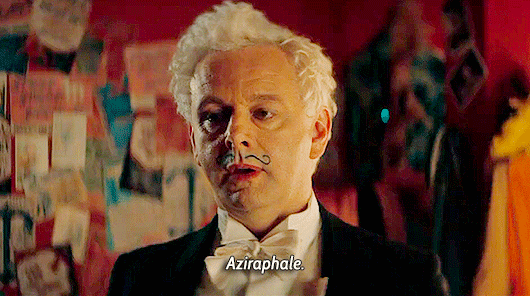
Furfur claims a past intimate relationship with Crowley, which Crowley spurns offhandedly. Crowley is playing Guinevere here, jilting Furfur/Arthur, which leaves the demon-smiting Aziraphale standing in for the handsome hero Lancelot (with his French connections, no less), and doesn't he make us weak at the knees when he drops his voice an octave in dominating disgust. (Is it suddenly getting hot in here...? Phew!)
Interestingly, looking back in S1 at 537AD Wessex, though, I would say that Crowley was Lancelot as the Black Knight, a role that Lancelot sometimes played in the legends, and Aziraphale would then be the fair maiden Guinevere. It certainly plays into Crowley's long term role of playing the knight who comes to the rescue of Aziraphale's princess in distress. Excalibur was no where in sight, perhaps still beneath the waters of the lake. Nor Arthur. Perhaps it was still too early in the story then...
I had originally suggested in my very first post that Furfur was given a stag as his demon avatar because he was wearing horns for being cuckolded by Crowley. But I wasn't quite thinking about it in context with the Arthurian legend! The stag is also often associated with royalty, plus while wandering around the medieval bestiary website that someone linked to, it interestingly notes that the enemy of the snake is the stag and the stork (Shax's avatar.) Ah ha!
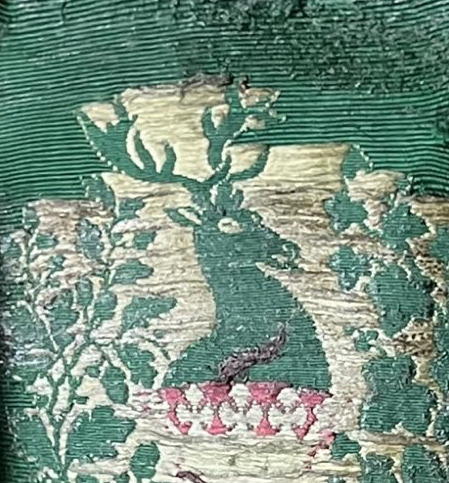
So how can we extrapolate this knowledge into a possible appearance of the Arthurian theme in S3?
Will we see the love triangle of Arthur/Guinevere/Lancelot come back into play and cause more chaos? I'm wondering if it might have something to do with the Fall.
Or will our lovers bring down a divinely-appointed ruler via their committed behind-the-back defiance of expected propriety?
Will Excalibur appear from beneath the waters, perhaps in another form, to declare a new king?
Could it even be a combination Jesus/Arthur, King of the World, returned? And they turn out to be a very naughty boy, disappearing into the night clubs of Times Square, New York, and that's how they lose him? (Social media viral sensation, anyone?)
I wouldn't be half-surprised if Greasy Johnson's name turns out to be Arthur, actually.
And no, I haven't forgotten that Adam's dad was named Arthur as well.
Bring on S3!
**Bonus**
If you've made it this far and you're thinking:
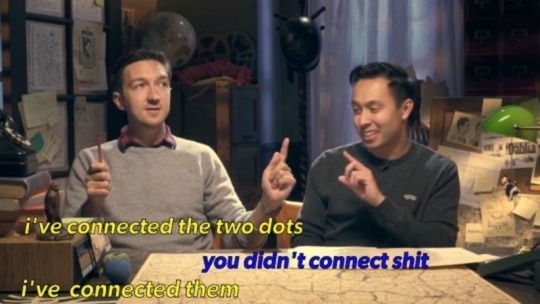
Let me leave you with this last connection.
In the back stage change room, remember Furfur delivers these lines:
FURFUR: What do you mean "have we?" You know we have. We were in the same legion. Just before the Fall. Doing dubious battle on the plains of Heaven. Remember?
On the first level, he is referring the Great War in the Good Omens AU.
On the second level, Furfur is paraphrasing Milton's Paradise Lost.
On a third level, I can (and will in a future meta) connect this back to the training initiative paintball fight at Tadfield Manor in S1.
And even deeper on a fourth level, if you do know the Holy Grail movie well, you'll remember there is an odd little subplot in it, that infers that the whole King Arthur and his knights thing is merely a full-on violent cosplay that is murderously rampaging across the countryside in the present day with the police in hot pursuit. It's a strange juxtaposition between reality and dream, and you aren't quite sure what it is real or not. The ending is bizarrely and abruptly surreal as the two story lines collide in the heat of battle, as the police turn up and arrest the combatants. A bit like this:
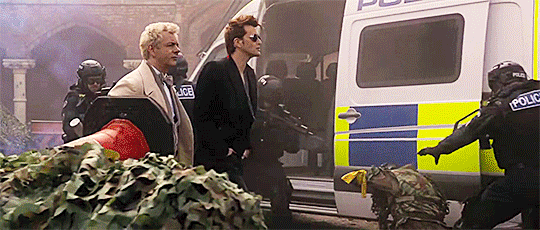
182 notes
·
View notes